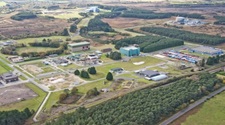
The Winfrith Nuclear Site was a major part of the UK’s nuclear research capability for several decades, with eight experimental reactors and related facilities located in an environmentally valuable area of heathland in Dorset. About half of the site has been released for use as a business park. The rest is being decommissioned and will be one of the earliest of the Nuclear Decommissioning Authority (NDA) sites to be completely cleared. Quintessa has been supporting the site’s operator, Research Sites Restoration Limited (RSRL), to develop a detailed description of the target End State for the restoration of the site, using a systematic and consultative options study.
Clearly defining the “End State” of a nuclear site is central to the decommissioning and restoration strategy, providing a key focus for the work. Recognising this, Winfrith’s operator, RSRL, worked with its stakeholders to establish the overall aims in 2007. The site is now entering a phase when major facilities are being decommissioned, and it has been necessary to add more detail to the End State definition. Questions such as how to manage very low concentrations of residual contamination, and the length of site stewardship after decommissioning, need to be answered confidently.
Although there is guidance on how to identify the best option for dealing with radioactive waste and decommissioning, this has not been applied in detail to a whole site before. RSRL needed to consider twelve key facilities, all with different characteristics, and determine the best overall strategy for restoring the site. It was also important to consult widely on the options for the site End State, with regulators and local stakeholders.
Quintessa has been assisting RSRL’s End State project for the last year focussing on the development and application of the process for defining and evaluating detailed site End State options. Our work has included reviewing and characterising the key facilities, understanding the site, determining a basis for assessing the long term risks, and supporting End State workshops with technical experts and stakeholders.
RSRL has now successfully determined its preferred option for the End State of the site, and submitted it to the Nuclear Decommissioning Authority in March 2014. The agreed site End State strategy will provide a framework for subsequent decisions on the detailed restoration objectives for each individual facility, ensuring that a coherent and optimised approach is taken.
Image courtesy of RSRL